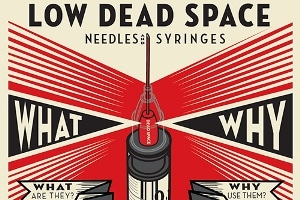Jan 9 2019
Towards the end of this month, new posters, an animation, and a booklet co-designed by service users from Bristol Drugs Project are being launched to advertise the advantages of low dead space injecting equipment for people who inject drugs, along with more extensive harm reduction messages.
 (Image credit: University of Bristol)
(Image credit: University of Bristol)
In low dead space equipment, the space between the needle and the plunger after injecting is less. Blood and drug stay in this space; therefore, when the equipment has more space for blood to be left, the risk of spreading blood-borne viruses such as HIV and Hepatitis C becomes higher when equipment is shared.
The materials will be launched at a special event at the Kitchen, the Station, Silver Street, Bristol BS1 2AG on Thursday, January 24th, 2019. The animation will have its premiere at the event, and there will be a chance to contact those involved in the project, including the service users themselves, along with an exhibition of the materials. The posters will be kept for public display from January 8th to 31st, 2019 in the gallery at the Station.
The materials have been developed following research by the National Institute for Health Research (NIHR) Collaboration for Leadership in Applied Health Research and Care West (CLAHRC West) and researchers Dr Jo Kesten and Professor Matthew Hickman from the NIHR Health Protection Research Unit (HPRU) in Evaluation of Interventions at the University of Bristol. As part of their study, it was found that people who inject drugs would volunteer to switch to this safer equipment if the advantages of less wasted drugs and lower risk of transmitting infections were explained and if they were brought into it slowly. In addition, the study informed some of the messages in the materials.
Deborah Hussey, Assertive Engagement Worker from Bristol Drugs Project, was funded by the Economic and Social Research Council (ESRC) and joined the CLAHRC West team as Knowledge Mobilization Fellow for the project. Deborah paid a visit to needle and syringe programs across the United Kingdom, from Glasgow to London, to gain insights into hurdles in the uptake of low dead space equipment, and how various programs run and share harm reduction messages.
Later, Deborah and the rest of the group collaborated with Michael Linnell of Linnell Communications, a designer specializing in information product design for alcohol, drugs, and public health campaigns.
With a series of workshops, service users from Bristol Drugs Project co-designed the materials and formed the messages, language, feel, and look of the materials. The final products can be downloaded from the website of Exchange Supplies—a social enterprise that has pioneered the use of detachable low dead space equipment among people who inject drugs.
The project was supervised by a steering group that included Bristol Drugs Project, Exchange Supplies, Public Health England, the Bristol Health Partners Drug and Alcohol Health Integration Team (HIT), CLAHRC West and HPRU in Evaluation of Interventions.
It has been a privilege to work on this project. It’s given me the opportunity to find out how other needle and syringe programmes operate, through shadowing and talking to staff, and having tours of their facilities. It’s been fascinating to compare how different places tackle things. I've valued the opportunity to help the service users on the project feel a real part of the team. We’ve had wonderful feedback from them about how empowered the process has made them feel, and how they felt their views were not only listened to, but were integral to the design process. It was an honor to enable this positive experience for them. I’m very proud of what we’ve produced together.
Deborah Hussey, Knowledge Mobilization Fellow, Bristol Drugs Project.
Increasing the use of low dead space injecting equipment has the potential to reduce the spread of blood-borne viruses. Although detachable low dead space injecting equipment is available, it isn't widely distributed through needle and syringe programmes. This project is an important step towards encouraging needle and syringe programmes to introduce this equipment and helping service users get used it. It has great potential to reduce the harms of injecting drugs. It's been incredibly valuable to work with Deborah on this project. Her knowledge and expertise have been key to its success.
Dr Jo Kesten, Principle Investigator, Bristol Drugs Project.
Dr Jo Kesten is a Senior Research Associate in Social Science (Qualitative) Research in the Bristol Medical School: Population Health Sciences.
Low dead space needles and syringes (full version)
(Image credit: University of Bristol)